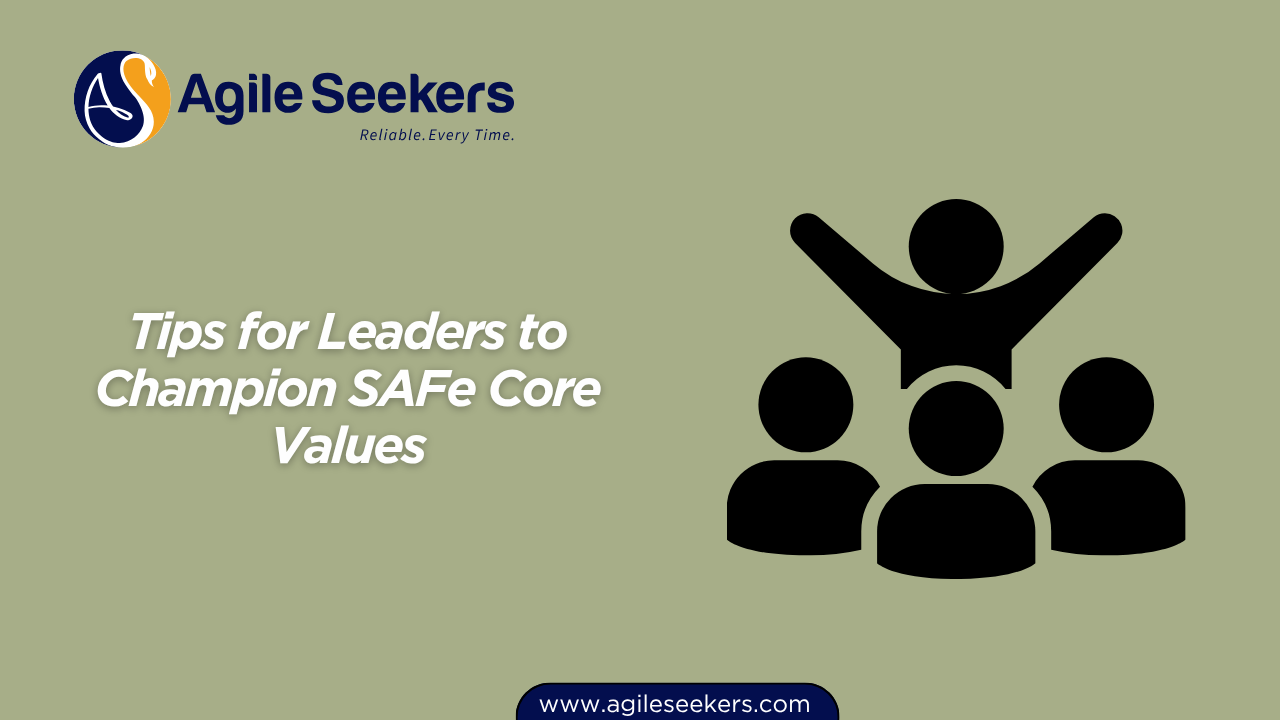Tips for Leaders to Champion SAFe Core Values

SAFe (Scaled Agile Framework) doesn’t get traction on slides or posters. Real change sticks when leaders make core values visible through daily actions and decisions. If you want teams to internalize SAFe, start here: leadership by example.
What Are SAFe’s Core Values?
Before we talk about how to champion them, let’s make sure we’re talking about the right things. The four core values in SAFe are:
-
Alignment
-
Built-in Quality
-
Transparency
-
Program Execution
This isn’t just theory. These values drive better decisions, faster learning, and outcomes that actually move the business forward.
1. Alignment: Stop the Silo Mentality
What this really means: Get everyone rowing in the same direction. When strategy, portfolio, and teams are in sync, priorities don’t shift with every new email.
Tips for Leaders:
-
Set clear, visible priorities. Make your intent public—use Objectives and Key Results (OKRs) or strategic themes. Reference them in every major conversation.
Example: Instead of vague “focus areas,” have quarterly priorities that everyone can recite. -
Break the echo chambers. Invite teams from different functions to planning and review sessions. Force cross-team visibility—especially when there’s risk or change.
-
Connect strategy to execution. Use tools like Portfolio Kanban and regular PI Planning. Show how epics and features roll up to strategy.
For a deep dive, see Leading SAFe Agilist Certification Training.
Practical Resource:
Check out Harvard Business Review on Cross-Silo Leadership for more ways to break out of silos.
2. Built-in Quality: Don’t Trade Speed for Debt
What this really means: Don’t just get things done fast—get them done right, every time. Quality isn’t a department, it’s everyone’s job.
Tips for Leaders:
-
Set the bar and keep it visible. Create explicit policies on “done.” Enforce code reviews, automated testing, and acceptance criteria.
If the team’s “definition of done” is ambiguous, expect rework. -
Reward technical debt paydown. Recognize teams that fix root causes, not just those who deliver new features.
Shout out improvements in retros and demos, not just feature delivery. -
Invest in enablement. Support learning: workshops on TDD, pairing, or DevOps.
Product Owners: take the lead in prioritizing quality-related work. Explore the SAFe Product Owner/Product Manager POPM Certification for more.
Practical Resource:
The Agile Alliance guide to Built-in Quality explains the mindset shift and practical tools.
3. Transparency: No Surprises, No Games
What this really means: Make everything visible—good, bad, or ugly. If problems stay hidden, so do solutions.
Tips for Leaders:
-
Model radical candor. Share both progress and setbacks openly. Admit when priorities change or bets don’t pay off.
-
Visualize the work. Use team boards, dashboards, and real-time reports. Don’t wait for monthly status reviews—show progress and blockers daily.
-
Create psychological safety. Ask dumb questions. Celebrate “failure stories” that led to learning.
When people know it’s safe to surface problems, you’ll get real data to act on. -
Insist on open metrics. Show velocity, lead time, quality trends, and backlog health. Let teams see the same truth as management.
To foster this at the scrum level, start with SAFe Scrum Master Certification.
Practical Resource:
Read Google’s Project Aristotle findings on psychological safety to understand why transparency beats blame.
4. Program Execution: Results Over Rituals
What this really means: Don’t get stuck doing “Agile theatre.” Focus on delivering value, not just following process for the sake of process.
Tips for Leaders:
-
Track outcomes, not activity. Look at working software, customer feedback, and value delivered—not just how many meetings were held.
-
Shield teams from churn. Protect focus during Program Increments (PIs). Push back on scope creep and drive decisions when dependencies block progress.
-
Foster a bias for action. Don’t let analysis or debate stall progress. Encourage teams to experiment, demo early, and ship iteratively.
-
Celebrate the right wins. Highlight improvements to flow and delivery—not just new features.
Learn about the leadership mindset in SAFe Advanced Scrum Master Certification Training.
Practical Resource:
The Scaled Agile Framework’s official page on Program Execution breaks down the essentials.
How to Actually Make This Happen
a) Walk the Floor
Don’t lead from behind dashboards. Show up in daily stand-ups, inspect team boards, and ask questions about quality and flow.
b) Sponsor Cross-Team Learning
Invest in training and knowledge sharing, especially on topics like systems thinking and lean leadership.
For advanced leaders, consider SAFe Release Train Engineer Certification Training.
c) Make Time for Retros
Retrospectives aren’t just for teams—they’re for leaders, too. Regularly gather leadership to inspect how well you’re modeling core values.
d) Use Data, But Stay Human
Lean on metrics, but don’t forget context and conversations. Use both to drive decisions and improvement.
Key Takeaways
-
Lead by example. Every time you choose transparency or quality over convenience, you reinforce SAFe’s core values.
-
Don’t delegate culture. The tone you set trickles down—if you hide problems or cut corners, teams will do the same.
-
Make core values visible. Embed them into the way you talk, decide, reward, and reflect.
Final tip: Want to drive adoption? Don’t preach—practice. The rest follows.
Also read - Empowering Teams through Decentralized Decision Making in SAFe
Also see - Why Embracing a Growth Mindset Matters in Lean Agile Environments




















